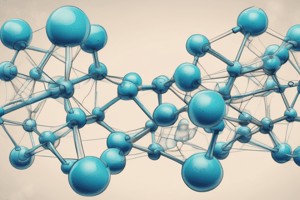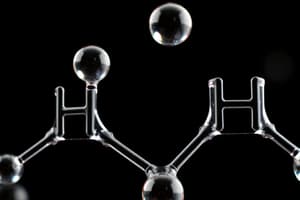Podcast
Questions and Answers
Why are aldehydes less common in drugs?
Why are aldehydes less common in drugs?
- They are less reactive and resistant to metabolic oxidation
- They are more reactive and prone to metabolic oxidation (correct)
- They are unstable and difficult to synthesize
- They have no functional groups to interact with binding sites
What role do amines play in medicinal chemistry?
What role do amines play in medicinal chemistry?
- They are involved in hydrogen bonding and ionic interactions (correct)
- They act only as hydrogen bond acceptors
- They are only found in aromatic compounds
- They are not important functional groups in medicinal chemistry
How many hydrogen bonds can a primary amine form?
How many hydrogen bonds can a primary amine form?
- Two as both a hydrogen bond donor and acceptor
- None, they only form ionic interactions
- One as a hydrogen bond acceptor
- One as a hydrogen bond donor (correct)
Why do aromatic and heteroaromatic amines only act as hydrogen bond donors?
Why do aromatic and heteroaromatic amines only act as hydrogen bond donors?
What happens to an amine when it interacts with its target binding site?
What happens to an amine when it interacts with its target binding site?
What is the purpose of studying an amide analogue?
What is the purpose of studying an amide analogue?
Why does an amide analogue prevent the nitrogen from acting as a hydrogen bond acceptor?
Why does an amide analogue prevent the nitrogen from acting as a hydrogen bond acceptor?
Why can't the right-hand structure in Fig. 13.13a form an ionic interaction?
Why can't the right-hand structure in Fig. 13.13a form an ionic interaction?
What is the primary function of the carbonyl oxygen atom in amide bonds?
What is the primary function of the carbonyl oxygen atom in amide bonds?
Why does the nitrogen atom in an amide bond not act as a hydrogen bond acceptor?
Why does the nitrogen atom in an amide bond not act as a hydrogen bond acceptor?
What is unique about the alkene analogue that makes it a useful test for amide binding interactions?
What is unique about the alkene analogue that makes it a useful test for amide binding interactions?
Why are ketone, secondary amine, and tertiary amine analogues not ideal for testing amide binding interactions?
Why are ketone, secondary amine, and tertiary amine analogues not ideal for testing amide binding interactions?
What type of amide is most commonly found in peptide lead compounds?
What type of amide is most commonly found in peptide lead compounds?
What is the result of the partial double bond character of the amide group?
What is the result of the partial double bond character of the amide group?
What is the term for amides that are within a ring system?
What is the term for amides that are within a ring system?
What is a potential function of the N–H group in primary and secondary amides?
What is a potential function of the N–H group in primary and secondary amides?
What is the effect of the acyl group on the hydrogen bonding interaction in an ester analogue?
What is the effect of the acyl group on the hydrogen bonding interaction in an ester analogue?
Why is the carbonyl oxygen potentially a less effective hydrogen bond acceptor?
Why is the carbonyl oxygen potentially a less effective hydrogen bond acceptor?
What is the main difference between an ester and an alcohol in terms of electronic properties?
What is the main difference between an ester and an alcohol in terms of electronic properties?
Why is the cyclohexane ring less likely to bind well to the binding site?
Why is the cyclohexane ring less likely to bind well to the binding site?
What is the role of the axial protons in the cyclohexane ring?
What is the role of the axial protons in the cyclohexane ring?
What is the possible interaction between aromatic rings and an aminium or quaternary ammonium ion?
What is the possible interaction between aromatic rings and an aminium or quaternary ammonium ion?
Why would the cyclohexane ring be incapable of fitting into a narrow slot in the binding site?
Why would the cyclohexane ring be incapable of fitting into a narrow slot in the binding site?
What is the main difference between an aromatic ring and a cyclohexane ring in terms of structure?
What is the main difference between an aromatic ring and a cyclohexane ring in terms of structure?
What is the main reason why alkenes are able to interact with hydrophobic regions of the binding site?
What is the main reason why alkenes are able to interact with hydrophobic regions of the binding site?
What is the significance of testing the equivalent saturated analogue of an alkene?
What is the significance of testing the equivalent saturated analogue of an alkene?
What is the advantage of using ketones in medicinal chemistry?
What is the advantage of using ketones in medicinal chemistry?
What is the orientation of the lone pairs of electrons on the carbonyl oxygen in a ketone?
What is the orientation of the lone pairs of electrons on the carbonyl oxygen in a ketone?
What is the effect of reducing a ketone to an alcohol on its geometry?
What is the effect of reducing a ketone to an alcohol on its geometry?
What is the reason why dipole-dipole interactions between a ketone and the binding site are weakened upon reduction to an alcohol?
What is the reason why dipole-dipole interactions between a ketone and the binding site are weakened upon reduction to an alcohol?
Why might the ether or ester analogues of a ketone be studied?
Why might the ether or ester analogues of a ketone be studied?
Why are reactions that can reduce a ketone completely to an alkane unlikely to be practical for many lead compounds?
Why are reactions that can reduce a ketone completely to an alkane unlikely to be practical for many lead compounds?
What is the primary mechanism by which penicillins inhibit bacterial enzymes?
What is the primary mechanism by which penicillins inhibit bacterial enzymes?
What type of interaction occurs between quaternary ammonium ions and aromatic rings?
What type of interaction occurs between quaternary ammonium ions and aromatic rings?
Why would converting a quaternary ammonium group to an amide prevent ionic interactions?
Why would converting a quaternary ammonium group to an amide prevent ionic interactions?
What is the role of carboxylic acid groups in drug binding?
What is the role of carboxylic acid groups in drug binding?
What is the purpose of synthesizing an analogue with a tertiary amine group?
What is the purpose of synthesizing an analogue with a tertiary amine group?
What type of bond is formed between lactams and their target?
What type of bond is formed between lactams and their target?
What is the function of acetylcholine's quaternary ammonium group?
What is the function of acetylcholine's quaternary ammonium group?
What is the potential consequence of converting a quaternary ammonium group to a tertiary amine group?
What is the potential consequence of converting a quaternary ammonium group to a tertiary amine group?
Flashcards are hidden until you start studying
Study Notes
Hydrogen Bonding Interactions
- Hydrogen bonding interactions may be weakened by replacing an alcohol group with an ester analogue, which cannot act as a hydrogen bond donor.
- The ester analogue may still act as a hydrogen bond acceptor, but the bulkier acyl group hinders the original hydrogen bonding interaction.
- The electronic properties of an ester differ from those of an alcohol, with the carboxyl group having a weak pull on the electrons from the neighboring oxygen, making the lone pair less effective as a hydrogen bond acceptor.
Binding Role of Aromatic Rings
- Aromatic rings are planar, hydrophobic structures that interact with flat hydrophobic regions of the binding site through van der Waals interactions.
- Replacing an aromatic ring with a cyclohexane ring can reduce binding due to the non-flat shape of the cyclohexane ring.
- Aromatic rings can interact with aminium or quaternary ammonium ions through induced dipole interactions or hydrogen bonding.
Binding Role of Alkenes
- Alkenes are planar and hydrophobic, allowing them to interact with hydrophobic regions of the binding site through van der Waals interactions.
- The activity of the equivalent saturated analogue would be worth testing, as the bulkier saturated alkyl region may not approach the binding site as closely.
Binding Role of Ketones and Aldehydes
- Ketone groups are planar and can interact with the binding site through hydrogen bonding, where the carbonyl oxygen acts as a hydrogen bond acceptor.
- The carbonyl group has a significant dipole moment, allowing for dipole-dipole interactions with the binding site.
- Reducing a ketone to an alcohol can significantly change the geometry of the functional group, weakening hydrogen bonding and dipole-dipole interactions.
Binding Role of Amines
- Amines are important functional groups in medicinal chemistry and can interact with the binding site through hydrogen bonding or ionic interactions.
- Primary and secondary amines can act as hydrogen bond donors, while aromatic and heteroaromatic amines act only as hydrogen bond donors due to the lone pair interacting with the aromatic or heteroaromatic ring.
- In many cases, the amine may be protonated when interacting with the target binding site, allowing for stronger hydrogen bonding or ionic interactions.
Binding Role of Amides
- Amides are likely to interact with the binding site through hydrogen bonding, where the carbonyl oxygen acts as a hydrogen bond acceptor.
- The nitrogen cannot act as a hydrogen bond acceptor due to the interaction with the neighboring carbonyl group.
- Primary and secondary amides have a N-H group, allowing the possibility of this group acting as a hydrogen bond donor.
Binding Role of Quaternary Ammonium Salts
- Quaternary ammonium salts can interact with carboxylate groups through ionic interactions or induced dipole interactions.
- The positively charged nitrogen can distort the π electrons of an aromatic ring in the binding site, inducing a dipole and allowing for interaction.
Binding Role of Carboxylic Acids
- Carboxylic acid groups can act as hydrogen bond acceptors or donors, or exist as the carboxylate ion, allowing for ionic interactions and/or strong hydrogen bonding.
- The carboxylate ion can act as a hydrogen bond acceptor, allowing for strong hydrogen bonding.
Studying That Suits You
Use AI to generate personalized quizzes and flashcards to suit your learning preferences.




